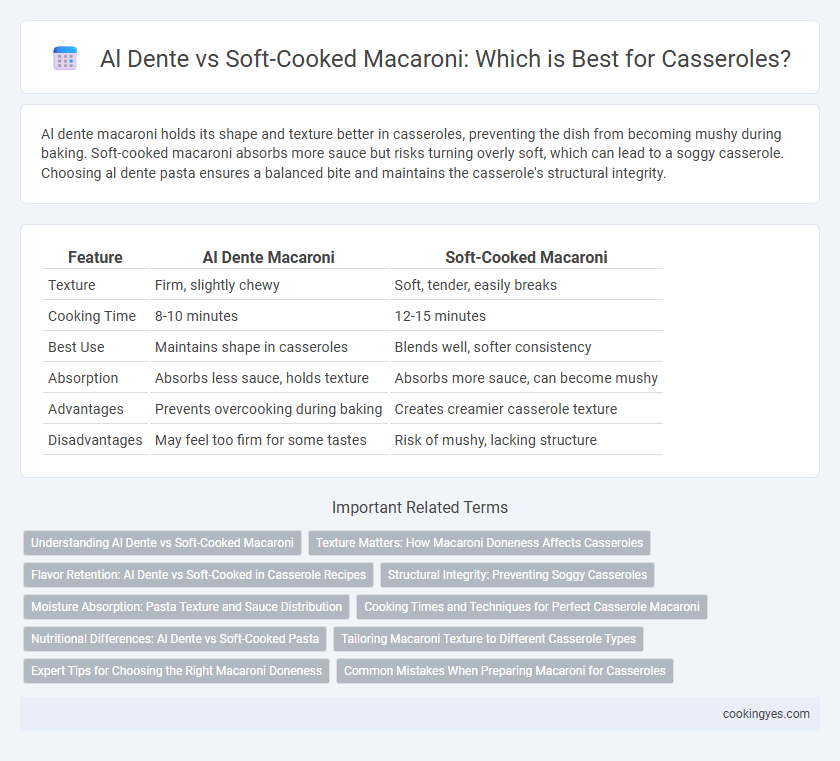Al dente macaroni holds its shape and texture better in casseroles, preventing the dish from becoming mushy during baking. Soft-cooked macaroni absorbs more sauce but risks turning overly soft, which can lead to a soggy casserole. Choosing al dente pasta ensures a balanced bite and maintains the casserole's structural integrity.
Table of Comparison
| Feature | Al Dente Macaroni | Soft-Cooked Macaroni |
|---|---|---|
| Texture | Firm, slightly chewy | Soft, tender, easily breaks |
| Cooking Time | 8-10 minutes | 12-15 minutes |
| Best Use | Maintains shape in casseroles | Blends well, softer consistency |
| Absorption | Absorbs less sauce, holds texture | Absorbs more sauce, can become mushy |
| Advantages | Prevents overcooking during baking | Creates creamier casserole texture |
| Disadvantages | May feel too firm for some tastes | Risk of mushy, lacking structure |
Understanding Al Dente vs Soft-Cooked Macaroni
Al dente macaroni holds its shape and offers a firm texture, making it ideal for casseroles that require baking, as it prevents mushiness during cooking. Soft-cooked macaroni absorbs sauces more readily but can become overly soft and lose structure when baked, potentially resulting in a less desirable casserole texture. Choosing al dente macaroni ensures a balanced bite and retains the integrity of the dish after exposure to heat.
Texture Matters: How Macaroni Doneness Affects Casseroles
Al dente macaroni retains a firm texture that provides a pleasant bite and prevents the pasta from becoming mushy during baking, ensuring the casserole holds its shape and contrast in each spoonful. Soft-cooked macaroni, while creamier, tends to absorb more sauce, resulting in a denser, less structured casserole that may become overly soft after prolonged cooking. Choosing al dente pasta optimizes the balance between tenderness and firmness, enhancing the overall texture and mouthfeel of baked casseroles.
Flavor Retention: Al Dente vs Soft-Cooked in Casserole Recipes
Al dente macaroni retains its firm texture and prevents overcooking during baking, preserving the pasta's subtle wheat flavor and enhancing overall dish complexity. Soft-cooked macaroni tends to absorb more sauce but can become mushy, leading to diminished flavor distinction and a less appealing mouthfeel in casseroles. Choosing al dente results in a balanced casserole with distinct pasta flavor and optimal texture retention.
Structural Integrity: Preventing Soggy Casseroles
Al dente macaroni maintains superior structural integrity in casseroles, resisting over-absorption of sauce and preventing sogginess. Soft-cooked macaroni tends to break down during baking, releasing excess starch and resulting in a mushy texture. Selecting al dente macaroni ensures a firm bite and preserves the casserole's cohesive texture throughout cooking.
Moisture Absorption: Pasta Texture and Sauce Distribution
Al dente macaroni maintains a firmer texture that effectively absorbs moisture without becoming mushy, enhancing the overall bite and preventing the casserole from becoming overly soggy. Soft-cooked macaroni absorbs more sauce quickly but can lead to a denser, creamier consistency while risking a loss of individual pasta structure. Optimal casserole results often favor al dente pasta for balanced sauce distribution and a satisfying, textured mouthfeel.
Cooking Times and Techniques for Perfect Casserole Macaroni
Cooking macaroni al dente for casseroles requires boiling pasta for 1-2 minutes less than package instructions, typically around 7-8 minutes, to ensure it retains firmness and structure during baking. Soft-cooked macaroni, boiled until fully tender for 10-12 minutes, can result in a mushy texture when baked, losing the desired bite in casseroles. Using precise timing and immediately rinsing al dente macaroni under cold water stops cooking and prevents over-softening, creating the perfect texture for creamy, well-structured casserole dishes.
Nutritional Differences: Al Dente vs Soft-Cooked Pasta
Al dente macaroni retains a lower glycemic index compared to soft-cooked pasta, promoting more gradual blood sugar absorption and sustained energy release. The firmer texture of al dente pasta preserves more resistant starch, which benefits digestive health and gut microbiota. Soft-cooked macaroni tends to have higher glycemic impact and may cause quicker spikes in blood glucose levels, making al dente a nutritionally advantageous choice for casseroles.
Tailoring Macaroni Texture to Different Casserole Types
Tailoring macaroni texture to casserole types optimizes dish consistency and flavor absorption. Al dente macaroni maintains shape and provides a firm bite, ideal for baked casseroles like macaroni and cheese or layered pasta dishes where structure is key. Soft-cooked macaroni blends smoothly into creamy casseroles, enhancing softness and melding flavors in recipes such as tuna or chicken casseroles.
Expert Tips for Choosing the Right Macaroni Doneness
Al dente macaroni retains a firm texture that prevents overcooking during baking, providing a perfect bite and structural integrity in casseroles. Soft-cooked macaroni absorbs more sauce, creating a creamier dish but risks becoming mushy under prolonged heat. Experts recommend starting with al dente pasta to balance texture and moisture, ensuring the casserole holds its shape while delivering optimal flavor.
Common Mistakes When Preparing Macaroni for Casseroles
Common mistakes when preparing macaroni for casseroles include overcooking pasta, which results in a mushy texture that absorbs too much sauce and becomes overly soft after baking. Underestimating carryover cooking in the oven leads to al dente macaroni turning too firm or chewy once the casserole finishes baking. Incorrect timing and not rinsing pasta after boiling can affect starch levels, causing clumping and uneven texture in the finished dish.
Al dente macaroni vs soft-cooked macaroni for casseroles Infographic

 cookingyes.com
cookingyes.com